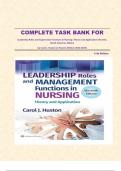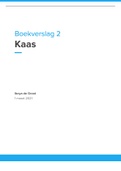COMPLETE TASK BANK FOR
Leadership Roles and Supervision Functions in Nursing: Theory and Application Eleventh,
North American Edition
by Carol J. Huston|| Newest Edition {2024-2025}
11th Edition
,Table Of Contents
Chapter 01: Choice Making, Problem Solving, And Critical Thinking: Requisites For Successful Leadership
And Supervision ............................................................................................................................................ 3
Chapter 02: Classical Views Of Leadership And Supervision ...................................................................... 18
Chapter 03: Twenty - First-Century Thinking About Leadership And Supervision ..................................... 33
Chapter 04: Ethical Issues ........................................................................................................................... 49
Chapter 05: Legal And Legislative Issues .................................................................................................... 66
Chapter 06: Patient,Subordinate,Workplace,And Professional Advocacy ................................................. 83
Chapter 07: Organizational Planning .......................................................................................................... 99
Chapter 08: Planned Change .................................................................................................................... 112
Chapter 09: Time Supervision ................................................................................................................... 126
Chapter 10: Fiscal Planning ....................................................................................................................... 141
Chapter 11: Career Planning And Development In Nurse ....................................................................... 157
Chapter 12: Organizational Structure ....................................................................................................... 172
Chapter 13: Organizational, Political, And Personal Power ..................................................................... 185
Chapter 14: Organizing Patient Care ........................................................................................................ 199
Chapter 15: Employee Recruitment,Selection, Placement,And Indoctrination ....................................... 211
Chapter 16: Educating And Socializing Staff In A Learning Organization.................................................. 227
Chapter 17: Staffing Needs And Scheduling Policies ................................................................................ 242
Chapter 18: Creating A Motivating Climate .............................................................................................. 256
Chapter 19: Organizational, Interpersonal, And Group Communication In Team Building ..................... 270
Chapter 20 : Delegation ............................................................................................................................ 284
Chapter 21: Conflict, Workplace Violence, And Negotiation ................................................................... 299
Chapter 22 : Collective Bargaining, Unionization, And Employment Laws............................................... 312
Chapter 23: Quality Control In Creating A Culture Of Patient Safety ...................................................... 322
Chapter 24 : Performance Appraisal ........................................................................................................ 332
Chapter 25 : Problem Employees: Rule Breakers, Marginal Employees, And Those With Substance Use
Disorder..................................................................................................................................................... 342
,Chapter 01: Choice Making, Problem Solving, And Critical Thinking:
Requisites For Successful Leadership And Supervision
1. What Statement Is True Regarding Choice Making?
A) It Is An Analysis Of A Situation
B) It Is Closely Related To Evaluation
C) It Involves Choosing Between Courses Of Action
D) It Is Dependent Upon Finding The Cause Of A Problem
ACCURATE ANS>>C
Feedback:
Choice Making Is A Complex Cognitive Process Often Defined As Choosing A Particular Course Of Action.
Problem Solving Is Part Of Choice Making And Is A Systematic Process That Focuses On Analyzing A
Difficult Situation. Critical Thinking, Sometimes Referred To As Reflective Thinking, Is Related To
Evaluation And Has A Broader Scope Than Choice Making And Problem Solving.
2. What Is A Weakness Of The Traditional Problem-Solving Model?
A) Its Need For Implementation Time
B) Its Lack Of A Step Requiring Evaluation Of Results
C) Its Failure To Gather Sufficient Data
D) Its Failure To Evaluate Alternatives ACCURATE ANS>>A
Feedback:
The Traditional Problem-Solving Model Is Less Effective When Time Constraints Are A Consideration.
Choice Making Can Occur Without The Full Analysis Required In Problem Solving. Because Problem
Solnving Attempts To Identify The Root Problem In Situations, Much Time And Energy Are Spent On
Identifying The Real Problem.
3. Which Of The Following Statements Is True Regarding Choice Making?
A) Scientific Methods Provide Identical Choices By Different Individuals For The Same Problems
, B) Choices Are Greatly Influenced By Each Person's Value System
C) Personal Beliefs Can Be Adjusted For When The Scientific Approach To Problem Solving Is Used
D) Past Experience Has Little To Do With The Quality Of The Choice ACCURATE ANS>>B
Feedback:
Values, Life Experience, Individual Preference, And Individual Ways Of Thinking Will Influence A Person's
Choice Making. No Matter How Objective The Criteria Will Be, Value Judgments Will Always Play A Part
In A Person's Choice Making, Either Consciously Or Subconsciously.
Page 1
4. What Influences The Quality Of A Choice Most Often?
A) The Choice Maker's Immediate Superior
B) The Type Of Choice That Needs To Be Made
C) Questions Asked And Alternatives Generated
D) The Time Of Day The Choice Is Made ACCURATE ANS>>C
Feedback:





